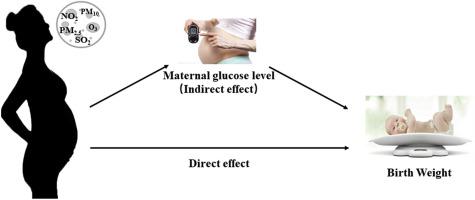Environmental Pollution ( IF 7.6 ) Pub Date : 2020-07-02 , DOI: 10.1016/j.envpol.2020.115128 Yin Yang 1 , Qingmei Lin 2 , Ying Liang 2 , Zengliang Ruan 1 , Zhengmin Min Qian 3 , Kevin M Syberg 4 , Steven W Howard 4 , Changke Wang 5 , Bipin Kumar Acharya 1 , Qihao Zhang 6 , Haibo Ge 2 , Xueli Wu 2 , Kaihua Li 7 , Xiaoling Guo 2 , Hualiang Lin 1

|
Maternal blood glucose level is associated with fetal growth, therefore, its role in the associations between air pollution and birth weight deserves investigation. We examined the mediation effect of maternal blood glucose on the associations between maternal air pollution exposure and birth weight. A total of 10,904 pregnant women in Foshan, China during 2015–2019 were recruited. Oral glucose tolerance test (OGTT) was administered to each participant after late trimester 2. Air pollution data at the monitoring stations in residential districts was used to estimate exposures of each participant during trimester 1 and trimester 2. Mixed-effects linear models were used to estimate the associations between air pollution and birth weight. After controlling for ten covariates, the direct effect of PM2.5 and SO2 (each 10 μg/m3 increment) on birth weight was −15.7 g (95% CI: −29.4, −4.8 g) and −83.6 g (95% CI: −134.8, −33.0 g) during trimester 1. The indirect effect of PM2.5 and SO2 (each 10 μg/m3 increment) on birth weight by increasing maternal fasting glucose level was 6.6 g (95% CI: 4.6, 9.1 g) and 22.0 g (95% CI: 4.1, 44.0 g) during trimester 1. Our findings suggest that air pollution might affect the birth weight through direct and indirect pathway, and the indirect effect might be mediated by maternal blood glucose.











































 京公网安备 11010802027423号
京公网安备 11010802027423号